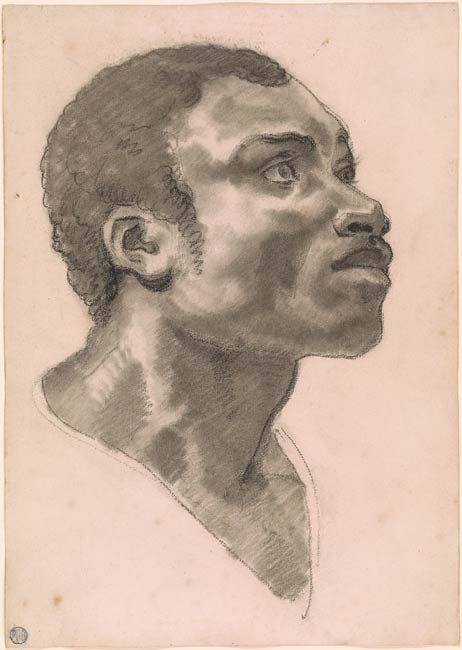
In September 1817, Gericault began work on his boldest composition, the epoch-defining and controversial painting Raft of the Medusa (1819; Louvre, Paris). He had a complicated, unorthodox working method and produced many studies as he developed the composition for the enormous canvas, including compositional ideas, figure studies, oil sketches, and cadaver studies.
Gericault employed a wide range of models, from close friends, including the young Delacroix, to the survivors themselves, studio assistants, professional models, and bodies seen in the hospital or morgue. In this careful head study, Gericault determines the angle of the head and combines hatching and stumping, or rubbing the soft chalk, to create a sculpturally modeled surface that is defined and animated by the fall of light. The same model appears in other studies for the painting, focusing on his body. The effort of the model to hold the pose is evident in the carefully closed mouth, nostrils flared for breathing, lifting of the chin, and high gaze aimed at a distance. This controlled studio pose was altered in the final painting, where the figure appears among four figures standing alongside the mast. His gaze is directed to the black sailor at the apex, who attempts to capture the attention of a passing vessel. The figure's face is slightly more exaggerated and harder to read in the shadows of the painting.
While Bazin rejected the drawing as not by the artist, Bruno Chenique included it in his 2012 exhibition devoted to the creation of the Raft. The softly stumped and modeled surface is unusual but can also be found in other studies by the artist for the painting, including a study in the Musée des beaux-arts, Besançon (D. 2154), of a man seen from behind, which uses the same technique.
Although based on a recent shipwreck that took place off the coast of West Africa as the ship was en route to Senegal, no black men were documented on the raft according to the testimony of survivors, but Gericault included three in his painting. The inclusion of the black sailors is resonant with republican, liberal sentiment and also reveals Gericault's interest in humanity writ broadly. Gericault's interest in a more diverse population of the raft came at a time when the expansion of the French colonies, the recent revolt on the French-owned island of Santo Domingo, not to mention concerns about France's role in the enslavement of Africans, were unfolding in public discourse. Shortly after completing the Raft, Géricault explored in drawings a scene devoted to the horrors of the transatlantic slave trade.
Stamped at lower left with the mark of Dubaut (Lugt S. 2103b).
Watermark: illegible fragment.
Dubaut, Pierre, former owner.
Lord, James, former owner.
Thaw, Eugene Victor, former owner.
Thaw, Clare, former owner.
The Morgan Library & Museum, New York, NY, "Drawn to Greatness: Master Drawings from the Thaw Collection", 2017. Exh. cat., no. 147, repr.
Denison, Cara D. et al. Drawings from the Collection of Mr. and Mrs. Eugene Victor Thaw. Part II. New York : Pierpont Morgan Library, 1985, no. 37, repr. (also in Thaw III, no. 68)
Denison, Cara D. et al. The Thaw Collection : Master Drawings and New Acquisitions. New York : Pierpont Morgan Library, 1994, no. 68.
Bazin, Germain., and Géricault, Théodore. Théodore Géricault, Étude Critique, Documents Et Catalogue Raisonné / Germain Bazin. Paris: Bibliothèque Des Arts, 1987. Vol. 5, no. 1910, as “auteur inconnu”.
Géricault, Théodore, Chenique, Bruno, Neuville, Aurore De, and Musée D'art Roger-Quilliot. Géricault, Au Cœur De La Création Romantique : Études Pour Le Radeau De La Méduse / Sous La Direction De Bruno Chenique ; [Édition, Aurore De Neuville]. Paris: Nicolas Chaudun, 2012, no. 10.
